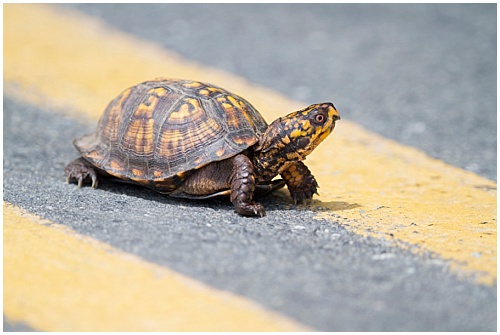May 14, 2021 at 9:26 pm
Spring is here and Maine’s turtles are on the move! Turtles have spent the long winter months dormant in streams, rivers, marshes, and ponds. As warmer weather returns, turtles emerge and begin moving around to warm themselves, find food, find mates, and nest. Unfortunately, as turtles begin traveling to find their necessities, they are increasingly confronted by habitat loss, fragmentation, and road mortality. The turtle shell provides sufficient protection from many natural predators, but it is no match for a car tire.

Turtles are long-lived animals that take many years to reach reproductive ages, in the range of 10-15 years for many Maine turtles. Their delayed maturity coupled with low hatching success creates exceptional challenges for survival. The annual loss of just a few adults to roadkill can lead to a population decline or even local extinction.
How to help a turtle cross the road:
- If you come across a turtle crossing the road and there is no oncoming traffic, allow the turtle to continue crossing without help. Observe from a distance to ensure it safely reaches the other side. If traffic is coming, don’t put yourself or others in danger, wait until traffic has slowed or stopped before assisting.
- If you pick a turtle up to assist, handle it carefully. Gently grasp the shell edge near the mid-point of the body with two hands and bring the turtle in the direction it is heading.
- Try to place the turtle at least 30 feet away from the roadside. Do not attempt to move the turtle to a different area, as the turtle will attempt to return to its original spot.
- Never grab a turtle by its tail – it could cause dislocation of its spine!
- If the turtle is large and heavy, such as a snapping turtle, you can use a car mat to slide the turtle with.
In collaboration with the University of Maine and Maine Audubon Society, MDIFW is identifying turtle road crossing and road mortality “hotspots.” With the assistance of the Maine Department of Transportation (MDOT), The Nature Conservancy, and local towns, we installed cautionary turtle signs in strategic locations in southern Maine warning motorists to watch for rare turtles on the roadway. The signs are permanent, but they fold closed so that they may be deployed seasonally, coinciding with the spring and summer period when overland turtle movements are greatest. This reduces sign fatigue by local commuters, hopefully increasing the signs’ impact. Our turtle signage project was one of the first of its kind among northeastern states and is now in its 15th year.
How you can help Maine’s turtles:
In addition to helping turtles cross the road successfully, there are several other ways you can help conserve Maine’s turtles. If a turtle is nesting on your property, erect a simple barrier around the nest once the turtle has left the area to protect the eggs from possible disturbance or predation. You can also volunteer as a citizen scientist by contributing valuable data to the Maine Amphibian and Reptile Atlas Project or to the Maine Turtle Roadkill Survey. Learn more about Maine’s turtles and projects here.